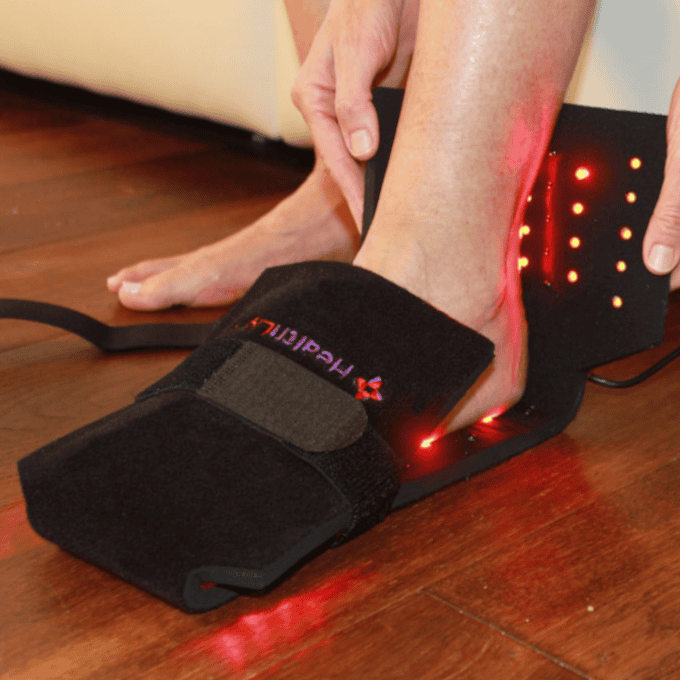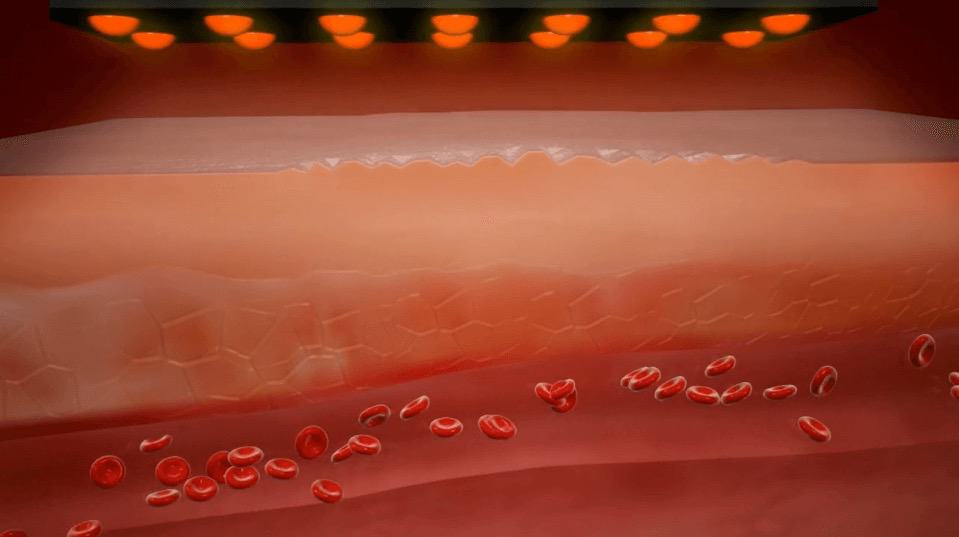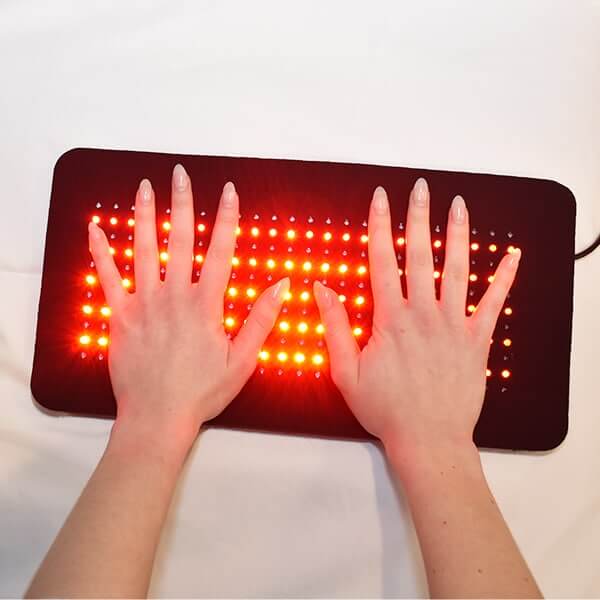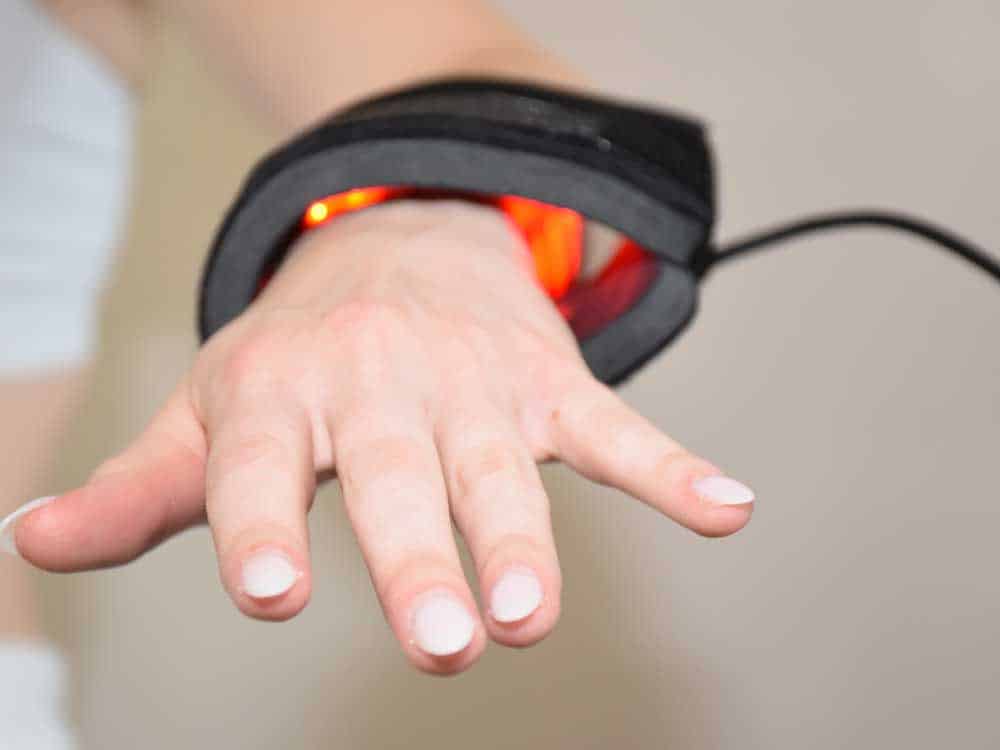Medically reviewed by Karen Wolters, RN.
Red light therapy is a form of low-level laser therapy that uses red and near-infrared light to improve circulation and reduce pain. The wavelength that works best for red light therapy is between 630 and 700 nanometers (nm).
The most commonly used wavelength for red light therapy is 660nm, which is within this range. This wavelength has been shown to penetrate deep into the skin and tissues, promoting blood flow and pain relief. Other effective wavelengths for red light therapy include 630nm and 850nm.

The HealthLight Foot & Ankle Pad
Drug-Free Relief Starts Here.
Feel the difference with clinical-strength red light therapy - right where you need it most.
It’s important to note that the effectiveness of red light therapy depends on various factors, including the intensity and duration of the treatment, the distance between the light source and the skin, and the individual’s skin type and condition. Therefore, it’s best to consult a qualified healthcare practitioner before using red light therapy for any medical conditions.
What is Red Light Therapy?
Red light therapy, also known as low-level laser therapy, uses red and near-infrared light to stimulate the body’s natural process. It has been used to treat a range of medical conditions, including chronic pain and arthritis.
What Wavelength Works Best for Red Light Therapy?
The most effective wavelength for red light therapy is between 630 and 700 nanometers (nm). Within this range, 660nm is the most commonly used wavelength for red light therapy. This wavelength has been shown to penetrate deep into the skin and tissues, increasing blood flow. Other effective wavelengths for red light therapy include 630nm and 850nm.
Does Any Red Light Work For Red Light Therapy?
When it comes to asking the question ‘does any red light work for red light therapy?’ you will need to know the details to ensure you pick the right device. Not all red lights are suitable for red light therapy. The therapeutic benefits of red light therapy depend on the specific wavelength of light used, which is typically in the range of 620 to 700 nanometers (nm).
While any red light can emit wavelengths within this range, the quality and consistency of the light produced by different types of bulbs and devices can vary significantly. For example, some red lights emit light in a broader range of wavelengths that may not be as effective for therapeutic purposes.
To ensure that you are using a red light that is appropriate for red light therapy, it’s important to use a device that has been specifically designed for this purpose and that emits light at the appropriate wavelength range. These devices are called “red light therapy pads” or “photobiomodulation devices.”
Shop Red Light Therapy Devices
What Are The Benefits of Red Light Therapy?
Red light therapy has been shown to have many benefits for physical health. Some of these benefits include:
- Gentle and Pain-Free: Near-infrared LED light therapy is a treatment option that is gentle and painless. It does not involve any cuts or injections, ensuring a comfortable and well-tolerated choice for individuals seeking alternative therapies.
- Versatility in Application: An important benefit of red light therapy is its versatility in treating various body areas (excluding the eyes). Whether targeting joint pain, muscle soreness, skin conditions, or other specific areas, near-infrared light therapy can be directly applied to the desired location.
- Natural Alternative: Red light therapy offers a natural alternative to expensive and potentially addictive medications. Instead of relying solely on drugs to manage pain or other conditions, individuals can explore the benefits of near-infrared light therapy as a drug-free option.
- Non-Surgical Option: For those considering costly and painful surgical procedures, red light therapy provides a non-surgical alternative. It can deliver relief without the need for invasive interventions, reducing associated risks and recovery time.
- Simplicity and Effectiveness: Red light therapy is a straightforward yet highly effective treatment approach. It involves the use of LED light devices that emit near-infrared wavelengths, which penetrate the skin and stimulate cellular processes. The treatment can be easily incorporated into daily routines and is known for its effectiveness across various applications.
- Simultaneous Treatment of Multiple Areas: Red light therapy enables the simultaneous treatment of different body areas using multiple pads. This feature enhances convenience and efficiency, as multiple regions can be addressed at once during a single session.
- Self-Administered at Home: Near-infrared LED light therapy is user-friendly and can be self-administered in the comfort of one’s own home. This accessibility makes it a convenient option for individuals seeking regular treatments without frequent visits to a healthcare professional.
- Integration with Multiple Modalities: Red light therapy can be combined with other therapies like chiropractic care, massage, physical therapy, PEMF therapy, or electrical stimulation. By integrating near-infrared light therapy with other modalities, therapeutic results can potentially be amplified, offering a comprehensive approach to wellness.
- Comfortable Multitasking: During near-infrared LED light therapy sessions, individuals can comfortably sit or lie down while receiving treatment. This allows for multitasking activities such as watching television, listening to music, reading, or talking on the phone, making it a convenient and enjoyable experience.
- Enhanced Circulation and Pain Relief: Red light therapy has demonstrated the ability to improve circulation and reduce pain. The near-infrared light wavelengths deeply penetrate tissues, promoting vasodilation and enhancing blood flow. Improved circulation can aid in tissue repair, reduce inflammation, and alleviate pain.
Factors To Consider When Choosing a Red Light Therapy Device
When selecting a red light therapy device, there are several important factors to consider to ensure you are getting a device that meets your needs and provides effective treatment. Here are some key factors to keep in mind:
- Wavelength: As we discussed earlier in this blog post, the wavelength of the red light used in RLT is a critical factor in its effectiveness. Ensure that the device you are considering uses a wavelength that is appropriate for the condition you want to treat.
- Power output: The power output of the RLT device can affect the treatment’s effectiveness. A higher power output device may be more effective but can also be more expensive.
- Size of the device: Consider the size of the device you need, depending on the area of the body you want to treat. A small device may be ideal for targeting a specific area, such as the face, while a larger device may be necessary for treating a larger area, such as the back.
- Type of device: There are different types of RLT devices available, including handheld devices, panels, and beds. Consider the type of device that will work best for you based on the area of the body you want to treat, how frequently you plan to use it, and your budget.
- Brand reputation: Research the brand and manufacturer of the device before purchasing. Look for reviews and ratings from other users to get an idea of the device’s effectiveness and reliability.
- Cost: red light therapy devices can range in price from a few hundred to several thousand dollars. Determine your budget and look for devices that meet your needs and are within your price range.
- Safety features: Look for devices with safety features such as auto shut-off timers or overheating protection. These features can help prevent injury or damage to the device.
By considering these factors, you can select a red light therapy device that meets your needs and provides effective treatment. It is always advisable to consult with a healthcare professional before using a red light therapy device, especially if you have any underlying medical conditions or concerns.
Shop Red Light Therapy Devices
Red Light Therapy Wave Lengths in Conclusion
Red light therapy is an effective and safe form of alternative medicine that uses red and near-infrared light to improve circulation and reduce pain. The most effective wavelength for red light therapy is between 630 and 700 nanometers (nm). Within this range, 660nm is the most commonly used wavelength for red light therapy. Other effective wavelengths for red light therapy include 630nm and 850nm. If you are considering red light therapy, consult a qualified healthcare practitioner to determine if it is right for you.
Start Your Pain Relief Journey Today
Contact us now and speak with a light therapy expert. They are here to help you find relief at home with soothing red light therapy.







